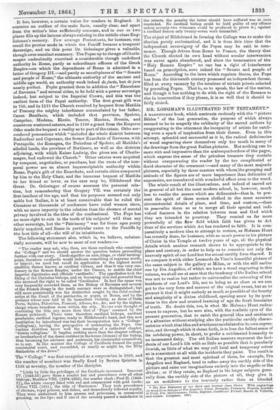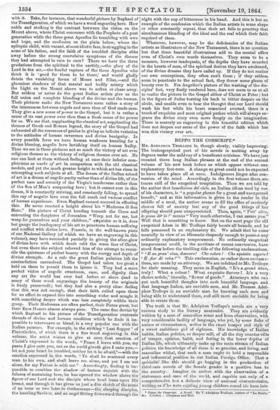MR. LONGMAN'S ILLUSTRATED NEW TESTAMENT.* A MAGNIFICENT book, which contrasts
curiously with the " pioture Bibles " of the last generation, the purpose of which always seemed to be to magnify the sublimity of the sacred authors by exaggerating to the uttermost the incapacity of artists for catch- ing even a spark of inspiration from their theme. Even in this attempt, splendid and successful as it is, the radical deficiencies of wood engraving show themselves only too much in many of the drawings from the great Italian pictures. But nothing can be more rich and impressive than the arabesqueborders of the pages, which express the sense of the priceless treasure they contain without overpowering the reader by the too complicated or florid character of the ornament :—and many of the most majestic pictures, especially by those masters with whom:the grouping and attitude of the figures are of more importance than delicacies of expression, are transferred with wonderful effect even to the wood.
The whole result of the illustrations, and indeed of sacred art in general of all but the most modern school, is, however, much less to realize the scenes which are delineated—that is, to pre- sent the spirit of those scenes clothed in the most accurate circumstantial details of place, and time, and custom,—than to generalize them so as to merge all their special and indi- vidual features in the relation between man and God which they are intended to pourtray. They remind us far more powerfully of the fiew field which faith has given to Art than of the services which Art has rendered to faith. It is com- paratively a modern idea to attempt to restore, as Holman Hunt has recently done, for instance, with so much power in his picture of Christ in the Temple at twelve years of age, all the physical details which anxious research shows to be appropriate to the place and century, in order to help us to conceive not only the heavenly spirit of our Lord but the actual earthly form thereof. It we compare it with either Leonardo da Vinci's beautiful picture of the same subject in the gallery at Milan, or with the still earlier one by Fra Angelico, of which we have a wood engraving in this volume, we shall see at once that the tendency of the Italian school was not to realize but rather to universalize the colouring of the incidents of our Lord's life, not to bring us as close as we can get to the very form and manner of the original event, but so to present it that it might embody as much as possible of the beauty and simplicity of a divine childhood, opening anew by its ques- tions to the slow and crusted learning of age the fresh fountains of truth. No doubt this, too, is what Mr. Holman Hunt endea- vours to express, but he sees also, with the realistic eyes of the present generation, that to catch the general idea and sentiment of a situation without studying also the particular earthly charac- teristics which that idea and sentimentmodulated to its own expres- sion, and through which it shone forth, is to lose the fullest sense of its subduing power, in short, to prefer a sublimated humanity to an incarnated deity. The old Italian masters represent the inci- dents of our Lord's life with as little as possible that is peculiarly Jewish, as little of what we may call local and temporary colour as is consistent at all with the incidents they paint. The result is that the greatest and most spiritual of them, for example, Fra Angelico and Raphael, tend to refine away the earthly side of the picture and raise our imaginations entirely into the angelic or the divine ; or if they retain, as Raphael in his larger subjects gene- rally does, the earthly side of the picture at all, they give it as an antithesis to the heavenly rather than as blended • The New Testament of our Lord arid Saviour Jesus Christ. With engravinp Pietro Perugino, FraT1011600 Francis, Lorenzo Gaudeuzto Feriae, Daniel di Voltam doni cwoodi:11,1Frira: dBein.ritiitome Feors
and others. Longman. 1805.
with it. Take, for instance, that wonderful picture by Raphael of the Transfiguration, of which we have a wood engraving here. How noble and striking is the contrast between the vision on the Mount above, where Christ converses with the Prophets of a past generation while the three great Apostles lie trembling with awe and hope, and the confusion on the plain below; where the epileptic child, with vacant, almost idiotic face, is struggling in the arms of his father, and the faith of the troubled disciples ebbs away before the strong convulsive symptoms of the disease they had attempted in vain to cure ! There we have the three gradations from the spiritual to the earthly,—the glory of the Lord in the air,—the fearful rapture of the three Apostles who think it is 'good for them to be there,' and would gladly detain the vanishing forms of Moses and Elias,—and the gloomiest shadows of that mental and bodily misery which the Light on the Mount above was to soften or chase away. But seldom or never do the great Italian artists give us the full union and complete blending of the divine and the human. Their pictures make the New Testament seem rather a story of the intercourse between angels and men than of God made man. They give a new sense of power to the Gospel, but it is rather a sense of its vast power over them than a fresh sense of its power for us. We see that, supplanting the classical art, supplanting the themes of Greek and Roman legend, the story of the Gospel had exhausted all the resources of genius in giving an infinite variation to the attitudes of human reverence and divine benignity. In every possible form we have human weakness kneeling for a divine blessing, angelic love lavishing itself on human frailty. Thus we see in these pictures not so much the victory of art over religious themes as the victory of religious themes over art. No one can look at them without feeling at once their inferior com- pleteness as works of art in comparison with the old classical models, and yet the much greater height to which art has risen in attempting such subjects at all. The dream of the Italian school of art is a dream of angelic purity rather than of divine life, of the perfect ease and serenity of the Virgin's tenderness rather than of the Son of Man's conquering love ; but it cannot rest in this dream, it is constantly striving, and constantly failing, to spread this ray of angelic love over the full reach and various conflict of human experience. Even Raphael cannot succeed in effecting this. Ile never reached a height above his "Madonna di San Sisto." His picture of Christ bending beneath the Cross and entreating the daughters of Jerusalem "Weep not for me, but weep for yourselves and your children," exquisite as it is, does but gauge the inadequacy of his art to penetrate human suffering and conflict with divine love. Francia, in the well-known pieta of our National Gallery (of which we have an engraving in this volume), may have succeeded partially in giving the after-glow of divine love with which death relit the worn face of Christ, but even there the subject relieved him of the attempt to recon-
cile the quietness of perfect beauty with the energy and depth of divine strength. As a rule the great Italian painters left the contradiction unresolved. The Gospel had taken too great a hold on them to permit them to ignore it. They had a more perfect vision of angelic sweetness, ease, and dignity than any art the world has ever had before or since (and in many of these wood engravings the beauty of the originals is finely preserved); but they had also a pretty clear feeling that this was not enough, that their faith called upon them for an effort to expand this into something wider and mingle it with something deeper which was less completely within their grasp. Their Madonnas are often perfect, their Pietas great, but their Ecce Homos almost always poor. The same fine device by which Raphael in his picture of the Transfiguration contrasts threads of divine and human condition which he finds it im- possible to interweave or blend, is a very popular one with the Italian painters. For example, in the striking " Last Supper" of Pinturiechio, of which there is a fine wood engraving in this volume, the artist wishes to give at once that emotion of Christ's expressed in the words, "Peace I leave with you, my
peace I give unto you, not as the world giveth give I unto you,—
let not your heart be troubled, neither let it be afraid,"—with the emotion expressed in the words, "Ye shall be .scattered every man to his own, and shall leave me alone, and yet I am not alone, for my Father is with me." Accordingly, finding it im- possible to combine the shadow of human anguish with the fulness of sustaining love, he has opened the window above the figure of our Lord and the disciple whose head leans upon His breast, and through it has given us just a dim sketch of the scene of an hour or two later in Gethsemane—the sleeping disciples, the kneeling Savior, and an angel flitting downward through the night with the cup of bitterness in his hand. And this is but an example of the confession which the Italian artists in some shape or other constantly repeat, that their art fails to pourtray that simultaneous blending of the ideal and the real which their faith required of them.
Whatever, however, may be the deficiencies of the Italian artists as illustrators of the New Testament, there is no question but that these beautiful illustrations add to the mental effect even of Christ's own words themselves. They seem to be a measure, however inadequate, of the depths they have sounded in the hearts of men, of the spiritual desires they have awakened, of the divine dreams they have called up. If they do not realize our own conceptions, they often exalt them ; if they seldom seem to penetrate to the actual fact, they throw some gleam of beauty over it. Fra Angelico's picture of the washing of the dis- ciples' feet, very finely rendered here, does not seem to us at all to realize the picture in the Gospel either of Christ or Peter ; but in the figure of Judas turning his back in bitter despair on the circle, and unable even to bear the thought that our Lord should wash his feet while his heart remained averted, there is a touch of exquisite and most original pathos which will always en- grave the divine story even more deeply on the imagination. There is scarcely an engraving in this beautiful edition Which does not deepen our sense of the power of the faith which has won this victory over art.































 Previous page
Previous page